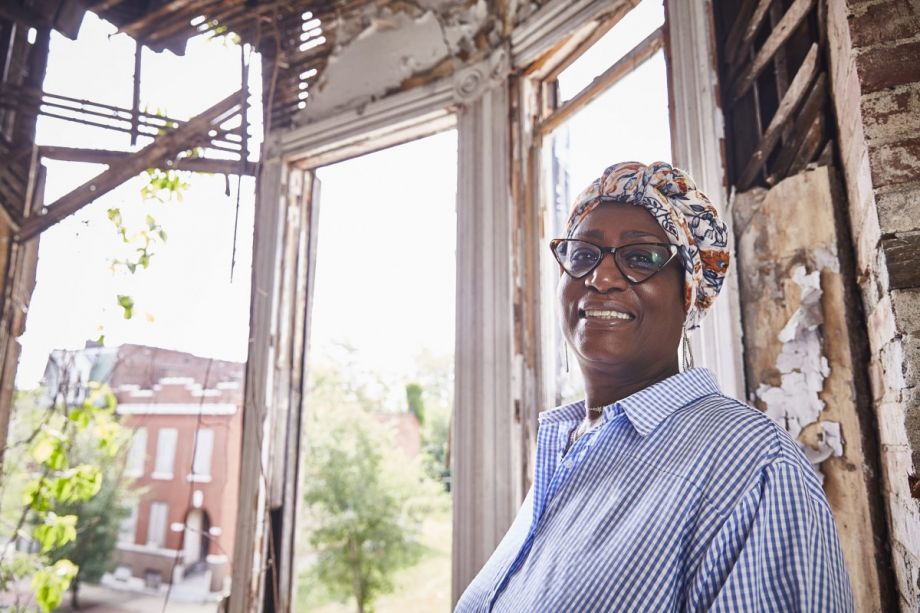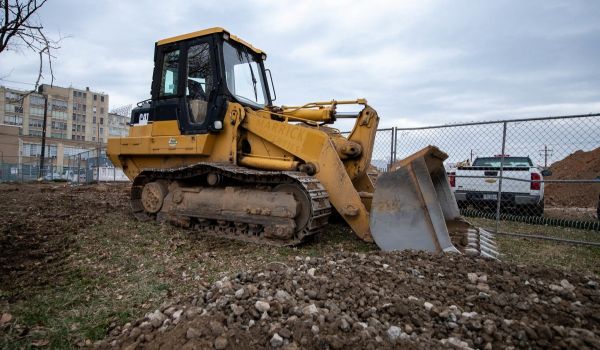“I grew up in the City of St. Louis, just on the other side of the Delmar Divide,” Kyri Morgan says.
“As kids, we would often play in vacant buildings, not knowing that they were filled with toxic materials and at risk of collapse, making them dangerous to us and to our communities.”
St. Louis is home to more than 30,000 vacant buildings and lots, the majority of which lie north of Delmar Boulevard: on the other side of the divide. In communities like Morgan’s, generations of racist housing policies and failed real estate markets left black neighbors living amongst blocks of vacant homes without access to key services and community institutions. Vacant properties attract crime, depress real estate values, and threaten the social and environmental wellbeing of neighborhoods.
This summer, Morgan is working alongside more than a dozen other students to reverse these trends through Dream Builders 4 Equity, a nonprofit that engages, educates and employs young people in the redevelopment of their communities. The organization was founded by Michael Woods and Neal Richardson, two leaders in the St. Louis community development field.
“We want to provide these young people with the proof that anything and everything is possible,” explains executive director Mike Woods. The organization accomplishes this through a comprehensive summer program combining youth jobs, leadership development, vacant property rehabilitation, support for minority contractors, financial empowerment, and arts-based entrepreneurship.
In short, students participating in Dream Builders 4 Equity are given paid summer jobs through STL Youth Jobs, enabling them to work alongside minority contractors to learn the fundamentals of the real estate and construction trades. The homes rehabilitated through the program are sold by Black-owned brokerages to first-time homeowners. The revenue from the sale is used to finance the program and to start college savings funds for each student participant.

Kyri Morgan addresses the audience at the Dream Builders 4 Equity Annual Book Signing, with Michael Woods (left) and Neal Richardson (center) looking on (Photo: Fam Establishment Media)
Woods emphasizes that the building of intergenerational wealth in black and brown communities is a priority for the organization. When interested buyers are not in a financial position to purchase the home, Dream Builders 4 Equity collaborates with the nonprofit Justine Petersen to offer these individuals credit building and financial management resources so that they may become homeowners in the future. The organization’s work also builds wealth for neighborhood residents as the rehabilitation and sale of new homes improves area real estate values.
For example, Morgan’s first involvement with Dream Builders was the summer of 2017, when he worked with a team of fellow students to rehabilitate a vacant home in the Lewis Place neighborhood, just blocks from where Morgan grew up. That home sold for $80,000 and was the first house sold in Lewis Place in 10 years. (As Next City has previously reported, a lack of “comps” in a neighborhood can effectively hamstring lending and depress property values.) The same year the Dream Builders home sold, another home in Lewis Place was sold for $120,000. This emphasis on wealth building is of particular importance when one considers the median wealth of a black family is less than 15% that of a white family; the home represents the vast majority of a household’s wealth.
Alongside real estate development activities, students also participate in financial literacy courses, engage with guest speakers, and receive leadership training. “Mentorship plays a key role,” Morgan says. “In our community, we don’t have a lot of guys like Mike and Neal to show us the opportunities we have to change our surroundings, to rehabilitate vacant buildings, to improve our communities.” With multiple years of program experience, Morgan now helps new students stay on track as a mentor.
Dream Builders 4 Equity also introduces students to arts-based entrepreneurship. Throughout the summer, students journal daily about their experiences. At the end of the program, each cohort compiles a selection of their journal entries – poems, stories, drawings – into a self-published book. All proceeds from book sales are given directly to the students.
Since launching in 2017, Dream Builders 4 Equity has provided sixty-two young people with over $600,000 in wages, over $40,000 in book sale proceeds, and over $60,000 in equity from the sale of homes. Dream Builders has recently adopted a place-based approach in order to maximize the organization’s impact in community.
The Dream Builders team works in close collaboration with the Hyde Park Neighborhood Association to engage residents in prioritizing vacant properties for rehabilitation. Neighbors identify nuisance properties (code violations, illegal activity, etc.) and, with the support of Legal Services of Eastern Missouri, the neighborhood association engages absentee landlords to rectify the problems. When owners do not respond, neighbors file a lawsuit against the property owner resulting in the deed being granted to the neighborhood association. The neighborhood association, in turn, designates developers like Dream Builders 4 Equity to rehabilitate the property.
Fatimah Muhammad, founder and chair of the Hyde Park Neighborhood Association, commends the positive impact Dream Builders 4 Equity is having in the neighborhood: “The organization supports youth, it supports local minority owned businesses, it has brought high-quality housing back to the neighborhood, and we see that people are moving in.” She goes on, “It has been amazing seeing all of the youth in the community working. It has been an inspiration to other young people in the community who have inquired through our neighborhood association how to get involved. Kids are really excited to see people who look like them, who are their age, really doing great things.”

Fatimah Muhammad, Founder and Chair of the Hyde Park Neighborhood Association (Photo: Fatimah Muhammad for We Power STL)
In addition to rehabilitating vacant properties, Dream Builders 4 Equity provides free owner-occupied home repairs for elderly and low-income neighbors. These repairs help resident’s build equity, stay in their neighborhoods, and enjoy a higher quality of life. Furthermore, this summer’s cohort is providing free lawncare services to 150 families in the Hyde Park neighborhood. Davian, one of this summer’s Dream Builders reflects on the importance of their work in community: “If you see beautiful houses, maintained parks, no trash, benches where you can sit and play… that is a community you want to live in.” He continues, “We go around the neighborhood and talk with people. Just good, friendly communication to build bonds. Because strong bonds build strong communities.”
Over the coming five years, the organization will focus exclusively on the Hyde Park neighborhood where they seek to rehabilitate 25 vacant buildings, repair 25 owner-occupied homes, and provide free lawn care and community development services for hundreds of families.
This year, Morgan will graduate from Ranken Technical College, one of the top trade schools in the country, and start work as an independent contractor. His education was financed through the sale of homes he helped construct. Morgan says, “Dream Builders gives me and other young people the opportunity to change our environment, to make those once-vacant homes beautiful, to create spaces where kids can play safely, to uplift low-income communities.” “With Dream Builders, we are not just starting a local movement. It’s a national and international movement to uplift low-income communities around the world. It’s starting here first. In St. Louis, Missouri.”
This article is part of Backyard, a newsletter exploring scalable solutions to make housing fairer, more affordable and more environmentally sustainable. Subscribe to our weekly Backyard newsletter.
Carrick Reddin is an urban planner and designer based between France and the United States. Through his practice, Carrick works with governments, nonprofits, and international organizations to foster environmentally sustainable, socially just communities.


















